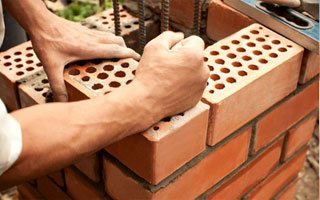Opening the Keys of Lasting Stonework Building And Construction Practices for Eco-Friendly Buildings
In the realm of modern construction, the search of lasting methods has ended up being vital. Amongst the myriad techniques to eco-friendly building, lasting masonry construction sticks out as a time-tested and sturdy method that holds a wealth of untapped potential. From the selection of materials to innovative building techniques, the secrets to accomplishing sustainability within masonry construction are complex and intriguing. By exploring the advantages, materials, techniques, and future trends of sustainable masonry, a deeper understanding of exactly how these methods can shape the future of environment-friendly buildings emerges.
Advantages of Lasting Masonry Construction
Welcoming lasting masonry building and construction techniques not just reduces ecological impact yet likewise uses lasting economic advantages to builders and communities. By using products like recycled blocks, obstructs, and stones, contractors can significantly lower the carbon impact of their jobs while promoting resource performance. Additionally, sustainable stonework building and construction methods, such as proper insulation and thermal mass buildings, can boost power effectiveness within buildings, resulting in decreased operational expenses over time.
In addition, the longevity and durability of stonework structures add to long-lasting financial advantages. Structures created using lasting masonry methods commonly require less repair and maintenance, converting to set you back savings for builders and property proprietors. The durability of masonry materials also guarantees that frameworks stay stable and safe, minimizing the requirement for frequent remodellings or substitutes.
Eco-Friendly Masonry Materials
Using environmentally friendly masonry products is an essential action towards improving the sustainability of building practices and reducing ecological impact while optimizing long-lasting economic advantages. Sustainable masonry materials are sourced, generated, and used in a fashion that lowers total environmental influence. Products such as recycled blocks, reclaimed stone, and sustainable cinder block are ending up being increasingly popular choices for eco-conscious builders. Recycled blocks, as an example, not just divert waste from landfills but additionally call for much less power to generate compared to brand-new blocks. Recovered rock offers a distinct visual allure while minimizing the requirement for new quarrying. Lasting concrete blocks integrate recycled aggregates and might feature enhanced insulation homes, adding to energy effectiveness in structures.
Additionally, all-natural materials like adobe, rammed earth, and straw bales give outstanding thermal mass buildings, decreasing the need for home heating and cooling down power. These materials are typically locally offered, promoting local economies and decreasing transportation-related carbon emissions. By selecting green stonework products, building and construction tasks can considerably lower their environmental footprint and add to the production of much healthier, more lasting constructed environments.
Energy-Efficient Stonework Methods
Energy efficiency plays an additional info important duty in boosting the sustainability of masonry building techniques. By applying energy-efficient stonework techniques, builders can significantly minimize the general power usage of a structure, resulting in reduced functional costs and a smaller ecological impact. One crucial energy-efficient stonework technique is the use of thermal mass, which click to read involves integrating dense materials like concrete or block right into the building's structure to take in and store warm. This aids regulate indoor temperature levels, minimizing the requirement for mechanical heating and cooling down systems.

Technologies in Sustainable Stonework
Current advancements in lasting stonework practices have brought about ingenious techniques that are reshaping the building industry. One such advancement is the growth of self-healing concrete, which utilizes bacteria installed within the concrete to recover cracks autonomously. This breakthrough not only minimizes maintenance expenses however also improves the resilience of stonework frameworks, contributing to their sustainability.
One more remarkable development is using recycled aggregates in masonry building - masonry contractor. By including products such as crushed ceramic waste or recycled glass right into concrete blends, home builders can decrease the ecological effect of construction tasks while maintaining architectural honesty. This practice not only diverts waste from landfills but additionally conserves all-natural sources, making it an essential development in lasting masonry building
Furthermore, the assimilation of digital layout tools, such as Structure Information Modeling (BIM), is transforming the means stonework frameworks are planned and constructed. BIM allows for more accurate computations, minimized product wastage, and boosted power effectiveness, eventually resulting in more lasting building techniques. These developments jointly represent an large patio pavers appealing future for sustainable stonework construction in the era of environment-friendly buildings.
Future Trends in Stonework Sustainability
With the cutting-edge strides made in lasting stonework practices, the future fads in masonry sustainability are poised to more revolutionize the building industry. Among the key trends shaping the future of masonry sustainability is the enhanced integration of innovation. Innovations such as Structure Information Modeling (BIM) and online reality simulations are being used to enhance masonry building processes, resulting in lowered material waste and enhanced power performance in structures.
Furthermore, the advancement of novel sustainable products is readied to play a substantial duty in boosting the eco-friendliness of masonry building. masonry contractor. Developments like self-healing concrete, recycled aggregates, and bio-based binders are gaining traction for their ability to minimize environmental impact while preserving architectural stability

Conclusion
In conclusion, sustainable masonry building practices provide numerous benefits for eco-friendly buildings. masonry contractor. Innovations in sustainable stonework are constantly being developed to even more improve the environmental efficiency of buildings.